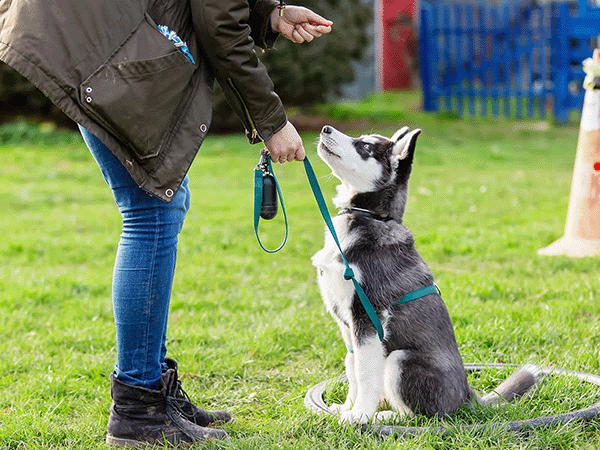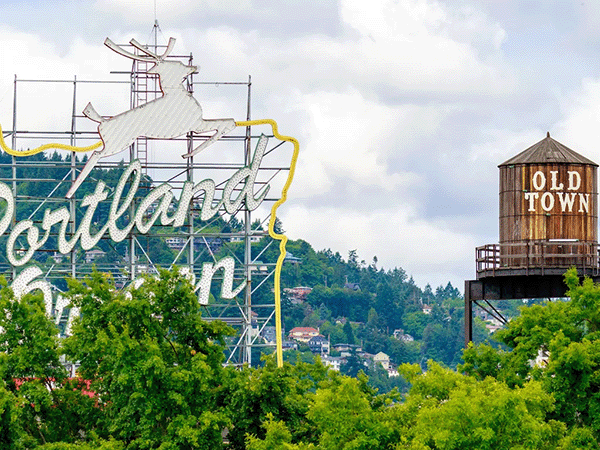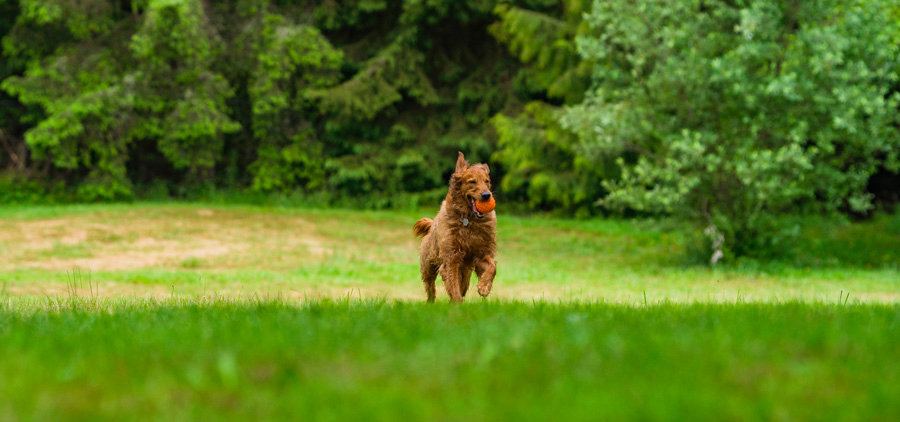Dirty Dog Syndrome: Causes, Solutions, and Prevention

It's a cringe-worthy moment every dog owner dreads: your furry friend chowing down on something truly disgusting. If your dog has a penchant for poop, you're dealing with coprophagia. It's more common than you think, and thankfully, often manageable. This article explores the reasons behind dirty dog syndrome, from instinct to learned behavior. We'll also give you practical tips to help break this unpleasant habit.
The technical terms for eating poop are “coprophagia” or “coprophagy.” It’s not always a cause for concern. Some level of this behavior is natural in our pets—canines are scavengers, after all—and is easily managed. But a poop obsession can also signal a larger underlying problem.
Here’s everything you need to know about coprophagia. How can you tell if your dog’s interest in feces is normal? Most importantly, how can you stop your poop eater from eating feces? Do you need to enlist a professional dog trainer? If so, what training methods are best?
Let’s dive in!
Eating poop can sometimes be a natural dog behavior
Key Takeaways
- Eating poop is a common dog behavior, especially in puppies: It's often driven by natural instincts like scavenging and exploration, and usually diminishes with proper training and a clean environment.
- Frequent poop eating can signal underlying issues: If your adult dog regularly eats feces, consult your vet to rule out medical conditions or nutritional deficiencies. A certified dog trainer can help address learned behavioral causes.
- "Dirty dog syndrome" isn't a medical diagnosis, but a term for dogs who repeatedly soil their den: This can be linked to early experiences, stress, or training mistakes. Reverse housetraining and positive reinforcement can help resolve this issue.
Why might adult dogs eat poop?
Mother dogs groom and clean their newborn puppies, including actually consuming their offsprings’ waste in their first few weeks of life. We know it sounds gross, but this is an important task! Eating their pups’ feces helps keep the nest sanitary. It also encourages the puppies to grow up with healthy hygiene habits of their own. (Dogs who are raised in unclean dens sometimes struggle with potty training in adolescence because they’ve never developed an aversion to using the bathroom where they eat or sleep. This is often referred to as “dirty dog syndrome”.)
In the above context, coprophagy is functional. It has other natural roots, too. Some researchers suggest the biological drive to eat poop is implanted as a survival instinct even in dogs who don’t have puppies.
Mild coprophagia also fits with what we know about how canines interact with each other in groups. Dogs are often able to sense infections in fellow animals—we commonly see canines sniffing or even licking any unusual discharges. This is presumably to gather more information about what’s going on with their kin. Detecting weaknesses can reflect on the overall safety of their pack (by which we just mean “social group” or “family”).
Why might puppies eat poop?
Coprophagia is a common problem in puppies. Good news, though—they usually grow out of it so long as they have a healthy environment and proper nutrition!
What does that means for you as a dog parent? If you recently brought your young dog home and they’re trying to eat feces, you don’t need to be too concerned.
Puppies are likely attracted to poop because of a few factors.
Exploring the World Through Scent and Taste
They’re incredibly playful—play is a key way juvenile animals learn important life skills! This means if they’re left unattended near their own poop (or that of another dog in the house) that hasn’t been cleaned up by their carer, there’s a good chance that what looks like gross waste to us will actually be an interesting toy to them.
The Puppy Oral Stage
What’s more? Puppies go through an oral stage where they primarily interact with the environment by licking, mouthing, and grabbing objects. These items can include, of course, poop.
Do Dirty Environments Lead to Dirty Habits?
Some puppies raised in the dirty environments mentioned in the previous section might be even more comfortable playing around with their feces. This can also happen with pups who are trained on puppy pee pads (what used to be called “paper training” years ago).
The Scavenging Instinct
Dogs are also natural scavengers. Most puppies grow into adults who only scavenge for things that are actually food (think about the dog at the local park who eagerly tries to pick up a discarded bone or piece of bread but only casually sniffs at a pile of poop left behind). When they’re young, though, dogs might naturally investigate dried or fresh stools.
Attention-Seeking Through Poop Eating
Playing with or consuming poop can also draw a lot of attention from owners. To many puppies, any sort of interaction is reinforcing. That means that we might inadvertently teach our dogs that grabbing poop starts a fun game. Oops. (This is one reason it’s very important to be clear about the messages we send—you can read more about basic dog training in our guide here!)
Learning by Example
There might be a product of observational learning here. Puppies might mimic the behavior of their mother or other playmates who perform coprophagy behavior.

Why do dogs like the poop of other animals?
Dogs are scavengers! It’s common for our canine companions to steal food, tear through garbage cans, and chew on plenty of things that we owners find disgusting ourselves. With proper training and other mental exercise outlets, this behavior can be reduced or eliminated entirely—but it’s important to remember that scavenging is a deeply rooted instinct in our dogs. There’s nothing inherently wrong with the tendency. It’s not a disorder in itself. We just have to manage it properly as pet parents.
Some animal feces has particularly “appetizing” attributes (taste, texture, and odor) that can override our dogs’ understanding that it’s waste and probably shouldn’t be consumed. Cat feces is a common culprit. So is that of deer, rabbits, or other small herbivores.
Coprophagia can also be an abnormal behavioral issue
Behavioral causes of your dog eating poop
Most dogs who eat feces do it because of learned behavior. It’s simply something they’ve learned to enjoy and doesn’t have an underlying medical cause.
Coprophagy can be caused by the instincts we talked about in the above section, especially if they’re coupled with an understimulating environment (a bored dog will find entertainment of their own) or a constant opportunity to eat poop (repeated ingestion can lead to a long-term habit). Dogs who grow up in unclean environments like puppy mills are especially prone to have issues developing potty training skills.
Medical causes of coprophagia
Some coprophagy is a symptom of underlying medical problems. Any disorder or condition that decreases your dogs’ absorption of nutrients or causes gastrointestinal upset has the potential to lead your pet to consume feces.
Underlying Medical Conditions and Coprophagia
- Cushing’s disease
- Thyroid disease
- Intestinal parasites
- Digestive enzyme deficiencies
- Anything being treated with steroids
- Anything resulting in a vitamin or mineral deficiency
If your dog is on a calorie restriction diet in order to lose weight, this can also increase their odds of developing a coprophagia habit. It’s important to always work with your veterinarian before making drastic changes to your pet’s food and treat intake!
If your dog takes a sudden interest in another dog’s stool—say your Labrador starts eating your Poodle’s poop every chance they get—that other dog’s fecal matter should be screened for a range of digestive conditions or disorders, too. This is because poor digestion of their own food might lead more nutrients to remain in their waste, thus increasing its appeal to other dogs.
What is Dirty Dog Syndrome?
Defining Dirty Dog Syndrome
Dirty dog syndrome isn’t a medical diagnosis. It’s a term that describes dogs who repeatedly pee or poop in their den (like a crate or other small, enclosed area) without any sign of distress or attempts to avoid soiling the space. Many dogs naturally want to keep their dens clean—especially adult dogs—so this behavior can be confusing and frustrating for pet parents.
Is it a Medical Condition?
Sometimes, dirty dog syndrome is related to an underlying medical condition, like a urinary tract infection (UTI) or digestive problems. It’s always a good idea to check in with your vet to rule out any potential health concerns, especially if the behavior appears suddenly or is accompanied by other symptoms like lethargy, changes in appetite, or vomiting.
Causes of Dirty Dog Syndrome
Housetraining Issues
If a dog spends too much time confined to a crate, especially as a puppy, they might lose the natural instinct to keep their den clean. If a puppy is constantly exposed to their own waste in their crate, they may start to associate the crate with eliminating, rather than a place to rest. This is especially true if accidents aren’t cleaned up promptly and thoroughly.
Medical Reasons
As mentioned earlier, medical issues can sometimes contribute to dirty dog syndrome. Conditions that affect digestion or urinary health can make it difficult for a dog to control their elimination, even in their crate. If your dog has any other changes in behavior or physical symptoms, a vet visit is essential.
Breed-Specific Traits
While not a primary cause, some breeds are naturally more prone to anxiety or have smaller bladders, which can make them more susceptible to accidents. This doesn’t mean they’re destined for dirty dog syndrome, but it highlights the importance of tailored training and management strategies.
Early Environment and Experiences
Puppies who come from unclean environments, like puppy mills, often have a harder time with potty training. They may not have developed the association between eliminating outside and a clean living space. Similarly, puppies trained using pee pads might generalize that it's okay to eliminate on any absorbent material, including their bedding.
Training Mistakes
Inconsistent or improper housetraining can also lead to dirty dog syndrome. Punishing a dog for accidents can create fear and anxiety, making them more likely to eliminate in their crate where they feel hidden. Positive reinforcement methods, like rewarding successful potty breaks outside, are much more effective.
Stress and Anxiety
Stress and anxiety can manifest in many ways, including changes in elimination habits. A dog might soil their crate due to separation anxiety, fear of loud noises, or changes in their routine. Addressing the underlying anxiety is key to resolving the dirty dog syndrome.
How to Stop Dirty Dog Syndrome: Training and Management
Reverse Housetraining: A Step-by-Step Guide
Reverse housetraining focuses on rebuilding the association between cleanliness and the crate. It involves gradually increasing the time your dog spends in a clean crate, rewarding successful potty breaks outside, and thoroughly cleaning any accidents.
Establishing a Routine
A consistent daily routine with scheduled potty breaks, feeding times, and playtime can help regulate your dog's elimination habits. Predictability reduces stress and makes it easier for them to learn when and where to go potty.
Managing Crate Time
Avoid leaving your dog in the crate for extended periods, especially in the early stages of reverse housetraining. Start with short durations and gradually increase the time as they demonstrate success. A properly sized crate is also important; it should be large enough for them to stand, turn around, and lie down comfortably, but not so large that they can eliminate in one corner and sleep in another. Check out our guide on crate training an older dog for more tips.
Gradual Transitions
Gradually increase the time your dog spends in the crate. Start with just a few minutes and gradually increase the duration as they show consistent success with staying clean. If they have an accident, go back to a shorter duration and build up again slowly.
Additional Tips for Success
Crate Size and Placement
Ensure the crate is appropriately sized. It should be large enough for your dog to stand, turn around, and lie down comfortably, but not so large that they can eliminate in one corner and sleep in another. Consider the crate's placement; a quiet, low-traffic area can help reduce stress and promote relaxation.
Puppy Pads: A Temporary Solution
If you're using puppy pads, try to gradually transition your dog to eliminating outside. Move the pad closer to the door, then outside on the porch, and eventually to your designated potty area in the yard.
Nighttime Potty Breaks
For puppies and dogs prone to nighttime accidents, schedule a potty break before bedtime and another one during the night. This can help prevent accidents and reinforce the habit of eliminating outside.
Re-crate Training
If your dog has developed a strong association between the crate and eliminating, you might need to start crate training from scratch. Introduce the crate as a positive space with treats, toys, and comfortable bedding. Gradually increase the time they spend in the crate, rewarding them for staying clean.
Positive Reinforcement
Always use positive reinforcement methods. Reward your dog with praise, treats, or a favorite toy when they eliminate outside. This helps them associate going potty in the right place with positive experiences.
Belly Bands for Containment
Belly bands can be a helpful tool for managing accidents, especially for male dogs. They provide a temporary solution for containing urine and can help prevent soiling the crate while you work on reverse housetraining.
Addressing Underlying Issues
If you suspect stress or anxiety is contributing to the problem, consult with a veterinarian or a certified professional dog trainer. They can help identify the underlying cause and recommend appropriate management strategies. You can find some top dog trainers on our blog.
Consistent Feeding Schedule
Feeding your dog on a regular schedule can help regulate their digestive system and make their elimination patterns more predictable. This makes it easier to anticipate when they need to go potty and take them outside accordingly.
Supervised Time and Freedom
When your dog is not in their crate, supervise them closely to prevent accidents. If you can't watch them constantly, confine them to a safe, easily cleaned area. Gradually increase their freedom as they demonstrate consistent success with potty training.
Enzymatic Cleaners
Use enzymatic cleaners to thoroughly clean any accidents in the crate or elsewhere in your home. These cleaners break down the odor-causing molecules in urine and feces, preventing your dog from being attracted to the same spot again.
When to Consult a Veterinarian
If your dog's dirty dog syndrome persists despite training and management efforts, or if it's accompanied by other symptoms, consult with your veterinarian. They can rule out any underlying medical conditions and provide guidance on appropriate treatment or behavioral interventions.
Setting Realistic Expectations and Patience
Overcoming dirty dog syndrome takes time and patience. Don't get discouraged if you don't see results immediately. Consistency with training, management, and positive reinforcement is key to success. Celebrate small victories and remember that every dog learns at their own pace.
Tools and Resources for Potty Training
There are many resources available to help with potty training, including books, online guides, and professional dog trainers. Consider seeking guidance from a certified professional dog trainer if you're struggling with dirty dog syndrome. They can provide personalized advice and support tailored to your dog's specific needs. Check out our guide to potty training for more information.
Understanding Dirty Dog Syndrome and Coprophagia
Dogs who enjoy eating poop might also be more willing to soil their bed, meal, and play environments. They struggle to learn potty training skills! Pet parents often call this dirty dog syndrome.
What is Dirty Dog Syndrome?
Dirty dog syndrome is not an official medical diagnosis. Rather, the term loosely refers to a dog developing a habit of using the bathroom in the same spot they sleep, eat, or play.
The most common form of dirty dog training is a puppy who pees or poops in their crate. Usually, dogs don’t want to go to the bathroom in their beds—which makes many pups perfect candidates for crate training. Our canine companions largely have a natural instinct to keep their den areas clean.
You can see how this is all related to coprophagia. Pets who are comfortable spending time around poop have a greater likelihood of trying to consume it, too. It can turn into an unproductive cycle.
The Link Between Puppy Mills and Dirty Dog Syndrome
Puppies kept in unsanitary conditions—and not exposed to clean, appropriate areas for elimination—might never learn to differentiate between where it’s acceptable and unacceptable to relieve themselves.
Any dog left without fresh water, healthy food, or adequate space to move around for an extended period of time is bound to develop problems. This risk is higher in pups during their critical socialization window.
Other Causes of Dirty Dog Syndrome
Puppy mill dogs aren’t the only ones who can struggle with dirty dog syndrome, though. Every dog is an individual. Sometimes behavior problems have a clear cause—and other times they don’t!
Some things that might contribute to dirty dog syndrome besides being raised by an unethical breeder include:
- Genetic factors
- Watching other pets use the bathroom indoors
- Medical issues like urinary tract infections
- Improper puppy pee pad or paper training
- Just about anything that can cause coprophagia can also lead to dirty dog syndrome
Addressing Potty Training Challenges
If your dog is struggling with their bathroom habits, don’t fret. You’re in good company. We’ve been there ourselves! And we’ve got you covered.
Here are some of our favorite blog posts to get you and your canine companion back on the right track.
- Sniffspot’s guide to potty training regression
- How to potty train a dog: The best training methods
- House training a puppy timeline: How long does it take?
- What to know about puppy pee pads
- Crate training program how-to

How do you know if your dog’s habits are cause for concern?
Adult dogs who love to eat poop
Occasional interest in poop—especially that of another animal, like a stray cat or deer who wanders through your backyard—is usually not a big deal. It should be fairly simple to manage with a well-timed leave it cue and some basic impulse control training.
If your dog’s poop eating becomes a habit, though? You’ll want to address it more specifically. This is especially true if coprophagy starts affecting what you feel like you can do with your dog. Consuming feces can become a quality of life concern if you’re afraid to walk your dog in public areas or feel you always have to be on the lookout.
Puppies who are fascinated with feces
Most puppies learn that food tastes better than poop pretty quickly. If your dog is more than a year old and still trying to regularly eat their own (or their housemate’s) poop, that’s no longer normal.
Behavioral training to stop your dog from eating poop
Do:
- Intervene early, as soon as you notice coprophagy becoming a habit. While some degree of poop consumption is normal in puppies, you should still take steps to reduce its occurrence as your dog grows up.
- Prevent your dog from having access to stools to eat. We know this is easier said than done—but a few simple steps can make a big difference. Consider keeping your pup in a safe wire or plastic crate, or a larger pen if they don’t have potty accidents of their own, when you’re unable to supervise them.
- Feed your dog on a consistent schedule and do not free feed them. This will help you accurately guess when they’ll need to use the bathroom, enabling you to go outside with them and immediately pick up any fresh stools before they can reach them.
- Creating a food and bathroom break diary or log can help you keep track of your dog’s habits. It has the added bonus of making sure everyone in your home stays on the same page, too!
- If you have multiple dogs, consider taking them outside at different times so you’re able to pick up their waste without interference.
- Take note of the form of your dog’s poop to help identify potential health problems. Healthy poop should be firm yet slightly soft to the touch.
- Practice your dog’s leave it and recall training. You can replace old, undesirable habits (like eating poop) with new, better ones (like coming to sit in front of you for a high value treat) through proper positive reinforcement training.
Don’t:
- Never stick your dog’s nose in their urine or stool if they have an accident inside your home. This could actually encourage coprophagy if they’re already prone to it.
- Don’t try only one thing at a time or give up too early. It’s best to include multiple of the above strategies into a long-term prevention program for at least a few months to make sure your dog has really broken the coprophagy habit.

Veterinary treatment of coprophagia
If you think your dog is eating poop because of an underlying medical condition (or if you just aren’t sure) it’s a good idea to take them in for a full physical examination. Your veterinary team will be able to help you determine any problems from medical history and current environment and treat them accordingly.
The first step is to identify the problem. Is it intestinal parasites? A nutritional deficiency? A problem with digestive enzymes? Then you can move into a treatment plan.
A few common options include treating any parasites present, changing your dog’s diet to one that’s more nutritious with different protein sources, avoiding byproducts in their food and treats, or adding extra fiber. Some dogs see improved digestion and nutrient absorption with certain enzyme supplements. Your vet will work with you and your individual dog!
When in doubt, get in touch with a professional trainer
Most of the time, you can treat coprophagy by yourself at home—even if you don’t have much training experience yet. As long as you stay consistent and patient, your dog will grow out of their gross habit and develop healthier responses through training in no time!
On occasion, though, some dogs require more help even if they’ve been given a clean bill of health by their veterinarian. In these cases, it’s a good idea to reach out to a professional force free trainer. They’ll be able to use their education and years of experience to develop a plan uniquely tailored to you, your dog, and your shared lifestyle. A combination of training tactics, medical assessments, and environmental management can go a long way.
Expert Trainer Review
There is so much misinformation out there, and we want to make sure we only provide the highest quality information to our community. We have all of our articles reviewed by qualified trainers with years of training experience.
This is the trainer that reviewed this article:
Penny Locke
Proudly offering Positive Reinforcement & Force-free Dog Training
www.allabout-canines.com
Related Articles
- Coprophagia: Why Does Your Dog Eat Poop? | Sniffspot
- Understanding Dog Behavior | Common Dog Behavior Problems
- Dog Tail Chasing | Chasing Tail Causes and Training
- Why Dogs Growl and How to Address It | Sniffspot Blog
Frequently Asked Questions
Is it normal for my dog to eat poop? It depends. Mother dogs consume their puppies' waste to keep the nest clean, and some scavenging behavior is natural for all dogs. Occasional interest in other animals' droppings isn't usually a big deal. However, frequent coprophagia, especially of their own or housemates' feces, can be a sign of a behavioral or medical issue, particularly in adult dogs. Puppies often explore the world through their mouths and may eat poop out of curiosity, but this behavior should decrease as they mature.
What can I do to stop my dog from eating poop? Start by managing your dog's environment. Supervise your dog closely during potty breaks and promptly clean up any feces. A consistent feeding schedule can make it easier to predict bowel movements. Work on "leave it" and recall training to redirect your dog's attention away from poop. If you have multiple dogs, consider separating them during potty breaks. Make sure your dog's diet is nutritionally complete.
Could my dog's poop eating be caused by a medical problem? Yes, certain medical conditions can contribute to coprophagia. These include problems that affect nutrient absorption, such as Cushing's disease, thyroid issues, intestinal parasites, and digestive enzyme deficiencies. A calorie-restricted diet can also increase the likelihood of poop eating. If you suspect a medical issue, consult your veterinarian.
What is "dirty dog syndrome," and is it related to coprophagia? "Dirty dog syndrome" refers to a dog repeatedly soiling their den or sleeping area. While not a medical diagnosis, it can be related to coprophagia. Dogs comfortable with poop may be less likely to avoid soiling their living space. It can also be caused by other factors, such as improper housetraining, stress, or medical conditions.
When should I consult a professional dog trainer about my dog's poop eating? If your dog's coprophagia persists despite your efforts, or if it's significantly impacting your quality of life, consider consulting a professional force-free trainer. They can assess your dog's behavior, environment, and training, and create a tailored plan to address the issue. A trainer can also help you determine if the behavior stems from anxiety, boredom, or other underlying issues.
Most recent articles

Dirty Dog Syndrome: Causes, Solutions, and Prevention
It's a cringe-worthy moment every dog owner dreads: your furry friend chowing down on something truly disgusting. If your dog has a penchant for poop, you're dealing with coprophagia. It's more common than you think, and thankfully, often manageable. This article explores the reasons behind dirty dog syndrome, from instinct to learned behavior. We'll also give you practical tips to help break this unpleasant habit.

Dog Enrichment Activities: The Ultimate Guide
Ever feel like your dog is restless or bored? They may be getting enough exercise, but still need more. That's where enrichment activities for dogs come in. Giving your dog opportunities to sniff, explore, and problem-solve can make a world of difference. Whether you have a puppy, adult, or senior dog, enriching their environment is key for their well-being. Let's explore how to add cognitive enrichment for dogs, even tailoring activities to your dog's breed with breed specific enrichment and fun enrichment games for dogs.

Labrador Retriever: Ultimate Guide by Owners
Discover the Labrador Retriever, a breed celebrated for its playful nature, affectionate temperament, and trainability. Labradors are known for their friendly demeanor and adaptability, making them perfect family companions and versatile working dogs. As one of the most popular types of retrievers, Labs are ideal companions for various lifestyles and are recognized by the American Kennel Club (AKC) as an excellent breed for families.

German Shepherd Dogs: Insights From Real Dog Owners
The German Shepherd Dog (GSDs) are known for their intelligence, loyalty, and striking appearance. They're also incredibly versatile, excelling as working dogs and devoted family companions. This guide covers everything you need to know about GSDs, from understanding their unique traits and rich history to practical advice on training and care. So, whether you're a seasoned GSD owner or just starting your research, let's explore this remarkable breed together.

Golden Retriever Advice: The Complete Owner's Guide
Golden Retrievers: they're gorgeous, playful, and incredibly popular. But before you welcome one into your home, you need the right golden retriever advice. This guide draws on the wisdom of nearly 10,000 Golden Retriever owners, offering practical tips for caring for these affectionate dogs. From understanding their high energy levels to mastering grooming and training, we'll cover everything you need to know. So whether you're already a devoted Golden parent or just starting your research, get ready to learn how to give your furry friend the best possible care.

American Staffordshire Terrier: Your Complete Guide
Think American Staffordshire Terriers are tough? Think again. While their muscular build might intimidate some, these dogs are known for their playful and loyal personalities. This guide draws on the experience of nearly 10,000 AmStaff owners to reveal the truth about this often misunderstood breed. Want to learn more about caring for an American Staffordshire Terrier? You're in the right place.
Related articles
Top dog guides per area
Dog training guides

Dog Food Aggression: Why You Shouldn't Punish It
Does your dog ever growl when you walk by their food dish? Maybe they get possessive of treats, carrying them far away and giving you side-eye when you start to approach — or snarling at your other pets or children if they get too close.

The Ultimate Guide to Scent Training for Dogs
Your dog's nose is an amazing tool. Did you know they have 40 times the olfactory receptors than humans? Scent training for dogs taps into this superpower, turning everyday moments into exciting sniff-fests. It's enriching for all types of dogs – reactive, shy, or simply adventurous. Ready to explore the world of scent work for dogs? Let's get started.

Service Dog Training Costs: DIY vs. Pro
More than 80 million Americans rely on their service dogs to help them navigate the world. Task-trained assistance animals perform a huge range of life-changing—in many cases, life-saving—services: These dogs act as eyes for visually impaired handlers, provide mobility support, alert to seizures and blood sugar crashes, interrupt anxiety attacks, remind their people to take medications, and so much more.

How to Deal With Puppy Potty Training Regression
You thought those dreaded middle-of-the-night potty breaks were over. You were finally free from cleaning up puppy puddles. Then, suddenly, your furry friend starts having accidents again. It's frustrating, right? This puppy potty training regression is more common than you think. Don't worry; we'll help you get your pup back on track. We'll cover the common causes, offer practical solutions, and give you actionable steps to tackle this challenge together.

Dirty Dog Syndrome: Causes, Solutions, and Prevention
It's a cringe-worthy moment every dog owner dreads: your furry friend chowing down on something truly disgusting. If your dog has a penchant for poop, you're dealing with coprophagia. It's more common than you think, and thankfully, often manageable. This article explores the reasons behind dirty dog syndrome, from instinct to learned behavior. We'll also give you practical tips to help break this unpleasant habit.

How to Train Your Rescue Dog: A Complete Guide
* All Sniffspot articles are reviewed by certified trainers for quality, please see bottom of article for details *
Dog enrichment guides

Top 10 Dog Water Parks in the US
Do you have a water-loving dog looking to burn some energy? There are countless dog parks to visit throughout our country — but some of them become far too hot in the midday sun to be safe for your pets to play. That’s why we’ve put together a list of some of the best dog water parks throughout the United States! At these locations, your pup can frolic, splash, and swim to their heart’s content.

Best Toys for Herding Dogs: Keeping Your Pup Happy & Engaged
Herding dogs are amazing, intelligent companions. But that also means they need more than just a simple game of fetch. Finding the right toys for herding dogs is key to keeping them happy and stimulated. This article explores some of the best toys for herding dogs, including options specifically for breeds like Border Collies and Australian Shepherds. We'll help you discover the perfect herding toys for dogs to tap into their natural instincts and keep them entertained for hours.

Tough Dog Toys for Aggressive Chewers: A Practical Guide
Does your dog destroy every toy you give them? Is your house littered with the remnants of plush toys? Are you tired of wasting money on "indestructible" dog toys for aggressive chewers that don't last? Then this post is for you. We'll cover everything you need to know about finding the best dog toys for aggressive chewers, so you can finally give your pup something safe, durable, and fun.

Daily Exercise Calculator: How Much Exercise Does Your Dog Need?
Everyone knows dogs need exercise, but how much is enough? Walks are great, but creating a truly balanced fitness plan means understanding your dog's specific needs. This post helps you develop a daily exercise calculator for your dog, considering breed, age, and lifestyle. We'll cover fun activities, understanding exercise intensity, and recognizing when your pup has had enough. Let's create a plan that keeps your dog happy and healthy!

Complete Guide To Herding With Dogs
* All Sniffspot articles are reviewed by certified trainers for quality, please see bottom of article for details *

Dog Enrichment Activities: The Ultimate Guide
Ever feel like your dog is restless or bored? They may be getting enough exercise, but still need more. That's where enrichment activities for dogs come in. Giving your dog opportunities to sniff, explore, and problem-solve can make a world of difference. Whether you have a puppy, adult, or senior dog, enriching their environment is key for their well-being. Let's explore how to add cognitive enrichment for dogs, even tailoring activities to your dog's breed with breed specific enrichment and fun enrichment games for dogs.
Dog reactivity guides

Rottweiler Aggression: Truth vs. Myth
Many dogs have gotten a bad reputation over the years for being "dangerous breeds." Rottweilers are among them. Like pit bulls and other large, blocky-headed types of dogs, these powerful and beautiful animals are often assumed to be aggressive.

What Is a Reactive Dog? A Practical Guide for Owners
Does your dog suddenly transform into a barking, lunging Tasmanian devil on walks? It's stressful for both of you. If this sounds familiar, you might have a reactive dog. Understanding what is a reactive dog is the first step to calmer walks. We'll explore the common triggers and give you actionable strategies to manage and modify this behavior. Let's turn those stressful walks into enjoyable outings.

How to Socialize a Reactive Dog: A Step-by-Step Guide
Does your dog display reactivity to other pets or people? Maybe they’re a new rescue pup and are still settling into your home. Or they were sick growing up, so you missed their critical socialization period. Possibly they’ve had a bad experience after being raised as a normal puppy.

What Is a Reactive Dog? A Complete Guide
Is your dog overly excited or fearful around other dogs? Do they bark, lunge, or whine? You might have a reactive dog. Many dog owners face this challenge. Understanding what a reactive dog is is the first step to helping them. This guide explores the common causes of dog reactivity, explains what makes a dog reactive, and offers practical tips and resources. Let's work together to build a stronger bond with your dog and enjoy stress-free walks.

Best Online Dog Training for Reactive Dogs: A Practical Guide
Does your dog's reactivity make walks stressful? You're not alone. Many dog owners face similar challenges. This guide offers practical advice and support for managing reactivity, including finding the best online dog training for reactive dogs. We'll connect you with reactive dog support groups, share training tips, and explore resources like the best dog training app for reactive dogs. Let's build a stronger bond with your dog, together.
* All Sniffspot articles are reviewed by certified trainers for quality, please see bottom of article for details *
How To Groom a Reactive Dog
* All Sniffspot articles are reviewed by certified trainers for quality, please see bottom of article for details *
Sniffspot community guides

The State of Public Dog Parks Across the United States
From 2009 to 2020, there was a 40 percent increase in the development of public dog parks. Designated spots for canine exercise have become commonplace in every major city in North America — many pet owners won’t even consider renting an apartment that doesn’t have its own fenced-in pet area for their canine companions.

How This Family is Affording Their Dream Property Through Renting it Hourly to Dogs
Thousand Oaks, California has been a safe haven for Sniffspot host, Jen, since childhood. Having grown up in busy Santa Barbara, Jen, an introvert from an early age, would seek out solitude and serenity away from tourists attractions and droves of people visiting from elsewhere. “My grandparents own 60 acres about a 30 minute drive from here, and I grew up spending every summer and every holiday visiting them on the ranch,” Jen explained. “In Santa Barbara, we wouldn't go to the beach on the weekend because that's where everybody was, so you'd find places off the beaten path where the tourists weren't. For me, the ranch was just my happy place.”

Host Tips: Ellen K. What Makes Sniffspot Successful for Me
Ellen is the host of Country Pasture Getaway, one of Sniffspot's most popular sniff spots. She has taken the time to write up the lessons she has learned about how to be a great sniff spot host.

How this Oregon Farmer is Making a Business From Renting Her Land to Dogs
Just 20 minutes outside of the busy city of Portland, Oregon, and settled right on the banks of the Columbia River, you’ll find what countless visitors have flocked to the area in search of – mountain views, crisp, clean air, and running water for miles. What you might not expect to find, however, is a hidden oasis designed just for dogs and their people, owned and operated by a farming couple and enjoyed by visitors on two legs, and four.

Host Tips: Fran T. Providing Great Guest Service at our Spot
Fran is the host of Ranch Setting, one of Sniffspot's most popular spots. She has taken the time to write up the lessons she has learned about how to be a great Sniffspot host.

How Sniffspot Helped a Nervous Rescue Work Through His Fears and Change His Family’s Life
This is the story of a family and dog rescuing each other.
Top dog trainers in the US

The Best Dog Trainers in the United States of 2025
This is a list of the top dog trainers in the United States, based on votes from the Sniffspot community and the general public.
The Best Dog Trainers in Seattle, WA of 2025
This is a list of the top dog trainers in Seattle, WA, based on votes from the Sniffspot community and the general public.
The Best Dog Trainers in Portland, OR of 2025
This is a list of the top dog trainers in Portland, OR, based on votes from the Sniffspot community and the general public.
The Best Dog Trainers in Los Angeles, CA of 2025
This is a list of the top dog trainers in Los Angeles, CA, based on votes from the Sniffspot community and the general public.
The Best Dog Trainers in New York, NY of 2025
This is a list of the top dog trainers in New York, NY, based on votes from the Sniffspot community and the general public.
City dog parks guides

Top 10 Indoor Dog Parks: A US Guide
Looking for a space to play with your dog no matter what the weather’s like outside? Look no further than our list of the best indoor dog parks in the United States! These climate-controlled spaces are growing in popularity as pet ownership increases throughout the country. As a bonus, many of them also offer dog training, boarding, grooming, or daycare services on the premises.

15 Best Dog Parks in the US: Public & Private
Searching for the best off-leash dog parks near you in the United States? Whether you're looking for public dog parks with open spaces or private, fully-fenced areas, this comprehensive guide has you covered. Discover top-rated parks across the country, plus essential tips on what to bring and what to expect for your next adventure.

Dog Parks Near Me: Las Vegas Edition
Looking for the perfect dog park near me in Las Vegas? You're in luck! This guide explores all the best options for your pup, from public dog parks to private dog parks near me on Sniffspot. We'll help you find the ideal spot for playtime, socializing, and fresh air. Plus, we'll cover essential etiquette and safety tips to ensure a happy visit for everyone. Get ready for some tail-wagging fun!

Top Sniffspot Locations: Find the Perfect Dog Park
Looking for the perfect dog park? Whether you need a wide-open public space or a private, fenced-in spot, this guide will help you find the best dog parks across the US. We'll cover top-rated public parks, the perks of private dog parks, and even explore Sniffspot locations – giving your pup a safe and fun place to play. Ready to find your dog's new favorite spot? Let's go!

Sniffspot: Portland's Best Private Dog Parks
Ready to discover Portland's best dog parks? Whether you're looking for a public park or the unique experience of a private Sniffspot, this guide has you covered. We'll help you find the perfect spot for your pup, with tips on what to bring, how to prepare, and even understanding dog body language. Plus, we'll explore some top Portland dog parks, including public and Sniffspot options, so you can plan your next dog-friendly adventure in the City of Roses.

Small Dog Park Guide: Tips for Finding the Perfect Spot
Finding the perfect dog park for your small breed can be tricky. Big dog parks can be overwhelming, even dangerous, for little pups. This guide helps you find the best small dog park for your little companion. We'll cover essential safety checklists and share recommendations for small dog parks across the US, including public and private options. We'll also discuss why a dedicated small dog park makes all the difference.
Dogs breeds

German Shepherd Dogs: Insights From Real Dog Owners
The German Shepherd Dog (GSDs) are known for their intelligence, loyalty, and striking appearance. They're also incredibly versatile, excelling as working dogs and devoted family companions. This guide covers everything you need to know about GSDs, from understanding their unique traits and rich history to practical advice on training and care. So, whether you're a seasoned GSD owner or just starting your research, let's explore this remarkable breed together.

Labrador Retriever: Ultimate Guide by Owners
Discover the Labrador Retriever, a breed celebrated for its playful nature, affectionate temperament, and trainability. Labradors are known for their friendly demeanor and adaptability, making them perfect family companions and versatile working dogs. As one of the most popular types of retrievers, Labs are ideal companions for various lifestyles and are recognized by the American Kennel Club (AKC) as an excellent breed for families.

Golden Retriever Advice: The Complete Owner's Guide
Golden Retrievers: they're gorgeous, playful, and incredibly popular. But before you welcome one into your home, you need the right golden retriever advice. This guide draws on the wisdom of nearly 10,000 Golden Retriever owners, offering practical tips for caring for these affectionate dogs. From understanding their high energy levels to mastering grooming and training, we'll cover everything you need to know. So whether you're already a devoted Golden parent or just starting your research, get ready to learn how to give your furry friend the best possible care.

American Staffordshire Terrier: Your Complete Guide
Think American Staffordshire Terriers are tough? Think again. While their muscular build might intimidate some, these dogs are known for their playful and loyal personalities. This guide draws on the experience of nearly 10,000 AmStaff owners to reveal the truth about this often misunderstood breed. Want to learn more about caring for an American Staffordshire Terrier? You're in the right place.

Australian Shepherd Facts: Breed Info & Care Guide
Discover the Australian Shepherd, an AKC breed celebrated for its trainable, playful, and affectionate nature. Despite its name, the Australian Shepherd is actually a native breed to the United States, originally developed to breed on farms and ranches. Considered a medium dog, Australian Shepherds were bred for herding beginning in the 1950s. As one of the high-energy breeds, Aussies are known for their boundless energy and need for regular exercise, including aerobic exercise.

Essential Husky Facts for Owners: Breed Guide
Discover the Siberian Husky, a breed celebrated for its curious, intelligent, and loyal nature. Considered a medium-sized dog, Siberian Huskies were originally bred in Russia for sledding, beginning in the early 20th Century. Today, they're one of the most popular active breeds in North America.














